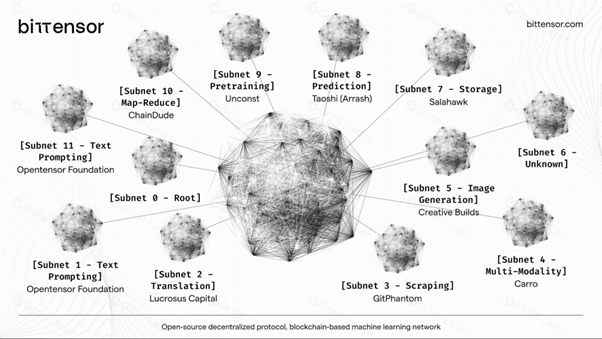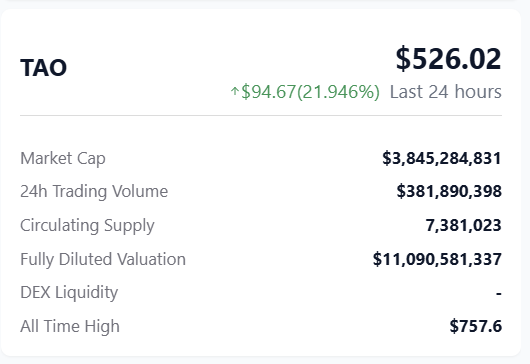November 6, 2024
This Crypto Is Leading the Decentralized AI Revolution
Dear Subscriber,
The anticipation of U.S. Election Day has dominated headlines for months.
In fact, it has commanded so much attention that otherwise earth-shaking events have passed by, almost unnoticed.
Like the new generation of AI agents that exploded onto the scene last week.
These are AI programs that can perform tasks independently and learn from their experiences.
If you didn’t hear about them, you’re not alone. I barely heard a whisper about them.
But AI agents are the next wave of AI development that will change how we live, work and play.
But there's a problem: The development of AI is mainly controlled by big corporations and research institutions, which have all the power and resources.
This centralization limits innovation. And it keeps AI advancements out of reach for many.
That's where Bittensor (TAO, Not Yet Rated) comes in.
This exciting project aims to make AI development more open, fair and accessible for everyone.
And in so doing, it is creating opportunities for investors, as well.
Imagine a massive, interconnected network where people from all over the world can contribute their AI models, share knowledge and even earn money from their contributions.
That’s Bittensor.
Its network acts like a "digital hive mind" where AI models can learn from each other and become more innovative and efficient with every interaction.

Source: Bittensor Development Doc.
Click here to see full-sized image.
In short, Bittensor is creating a marketplace for AI where knowledge becomes a tradable commodity.
This new approach can potentially open AI development to a diverse range of developers … not just the big players.
And that could change the AI game as we know it. Not just within the crypto space … but beyond.
See, training AI models requires enormous amounts of data and computing power. And the costs to support those resources can skyrocket.
That’s exactly why a few large corporations have emerged as the main drivers of AI development. The resource demand for AI makes it difficult for smaller companies or individual developers to compete.
The result? Innovation is limited, and AI models are often "siloed” and can't learn from one another.
That means every new AI has to learn everything from scratch. And I don’t need to explain how incredibly inefficient that is!
Bittensor aims to solve these inefficiencies in two key ways:
-
Spread out the resource burden: Training advanced AI models takes a lot of computing power, which is expensive and often only available to well-funded companies.
Bittensor leverages a decentralized network to reduce reliance on centralized resources, lowering the barriers to entry for AI development. That, in turn, makes the cost of using those AI models cheaper, as well.
-
Increase knowledge sharing: When developers start working on new models, they often can't build on the work of others. Instead, they start from scratch, wasting time and resources.
By facilitating collaboration between models, Bittensor enables knowledge sharing, drastically improving efficiency and reducing redundancy in AI development.
This is accomplished thanks to Bittensor’s decentralized and open-source network.
Through decentralization, Bittensor’s network becomes easily accessible to a much larger audience of developers and users.
And thanks to its open-source foundation, everyone is encouraged to access the code, contribute to its development and benefit from the community's collective efforts.
Additionally, unlike traditional methods of solving complex math problems — like Bitcoin's "Proof of Work" method — Bittensor relies on proof of intelligence, which is better suited to improving AI models.
That’s because, in proof of intelligence consensus, those models prove their value by performing machine learning tasks.
The better they do, the more they are rewarded.
Here's how it works:
- Nodes (Miners): Participants host and serve AI models, called nodes. If someone needs a prediction or wants to solve a problem, the request gets routed to the relevant node with the suitable AI model for the job.
- Validators: A second group of participants called validators check the quality of the node’s work. They ensure the predictions are accurate and trustworthy to help maintain the integrity of the network.
In true crypto fashion, the entire process is completely transparent for anyone to see.
This "cognitive economy" means that AI development will be more collaborative, innovative and powerful across the AI sector.
It seems likely that even the companies that once held control over AI — firms like IBM, Google and Microsoft — may need to tap into the Bittensor network as it offers something even they struggle with: A vast, diverse and ever-growing set of AI models that can learn from one another.

Source: Bittensor Development Doc.
Click here to see full-sized image.
This decentralized approach makes AI more efficient and capable than traditional, siloed systems.
And at the heart of this ecosystem is Bittensor’s native coin, TAO. It serves multiple roles in the Bittensor ecosystem.

Source: Depinscan.io.
Click here to see full-sized image.
First, it rewards node operators and validators by acting as a reward for their efforts. Think of it as a payment to contributors for sharing their AI models and the insights they generate.
Second, TAO is also how users can pay to access services within the network.
Finally, it also acts as a governance token. TAO holders are able to vote on essential network decisions.
This multi-faceted role makes TAO integral to the functioning and sustainability of Bittensor.
This isn't just about money — it's about recognizing value.
The more an AI model contributes, the more TAO tokens that the contributor receives. Those tokens can then be used to access other models, vote on network decisions or even just cash out for profit.
TAO has corrected over the past month. But like many leading cryptocurrencies, it bounced late yesterday and is up an impressive 13% so far today, and almost 22% in the past 24 hours!
And, according to talk from Token2049 — a premiere crypto conference that my colleague Dr. Bruce Ng covered earlier this year — TAO is projected to be a top 10 coin by market cap.
Bittensor is reshaping the AI landscape.
In a future where AI plays an even bigger role in our lives, Bittensor's decentralized neural internet could be the key to ensuring those advancements benefit all of us, not just the few.
Investors interested in the decentralized AI revolution should consider adding Bittensor to their watchlist.
And to learn what cryptos my colleague Juan Villaverde has on his watchlist, check out his latest briefing here.
Best,
Mark Gough